Eurozone
Quantitative Easing in Eurozone in 2016
The ECB started buying assets from commercial banks in March 2015 as part of its non-standard monetary policy measures. These asset purchases, also known as quantitative easing or QE, support economic growth across the euro area and help us return to inflation levels below, but close to, 2%. (Source: European Central Bank)
Under the leadership of Sylvain Broyer, Head of Macro Economic Research at Natixis in 2015, I wrote my master thesis about the impact of the Quantitative Easing on the Eurozone household saving rate. Kindly follow this link or download the report below to read the full report in French!
“Within our mandate, the ECB is ready to do whatever it takes to preserve the euro. And believe me, it will be enough.”
Mario Draghi, European Central Bank President from 01/11/2011 to 31/10/2019

Scenarios in Greece in 2015
While still in a student at Ecole Centrale Marseille, Florian Lanvin and I published an article in the the daily French financial newspaper, Les Echos. Based on Acemoglu and Robinson research papers (the two economists describe the transition mechanisms of political regimes), we determined 3 potential political scenario for the country. The article is available online here. We want to sincerely thank Roland Couture to allow us to share our thoughts!
“We develop a theory of political transitions inspired by the experiences of Western Europe and Latin America. Nondemocratic societies are controlled by a rich elite. The initially disenfranchised poor can contest power by threatening revolution, especially when the opportunity cost is low, for example, during recessions. The threat of revolution may force the elite to democratize. Democracy may not consolidate because it is redistributive, and so gives the elite an incentive to mount a coup. Highly unequal societies are less likely to consolidate democracy, and may end up oscillating between regimes and suffer substantialfiscal volatility. (JEL D72, D74, 015, P16)”
DARON ACEMOGLU and JAMES A. ROBINSON, A Theory of Political Transitions (2001)

HZero
HZero is a business and sales hypothesis management software venture founded in 2020.
Anne Cherian, A Good Indian Wife: A Novel

Anne Cherian was born and raised in Jamshedpur, India. She graduated from Bombay and Bangalore Universities and received graduate degrees in journalism and comparative literature from the University of California, Berkeley. She lives in Los Angeles, California, and visits India regularly.
A Good Indian Wife is her first novel.
Handsome anesthesiologist Neel prides himself on his decisiveness, both in and out of the operating room. So when he agrees to return to India to visit his ailing grandfather, he is sure he’ll be able to resist his family’s pleas that he marry a “good” Indian girl. With a girlfriend and a promising career back in San Francisco, the last thing Neel needs is an arranged marriage.
Leila is a thirty-year-old teacher in Neel’s family’s village who has watched too many prospective husbands come and go to think her newest suitor will be any different. She is well past prime marrying age; her family has no money for a dowry; and then there’s the matter of an old friendship with a Muslim boy named Janni.
Neel and Leila struggle to reconcile their own desires with the expectations of others in this riveting story of two people, two countries, and two ways of life that may be more compatible than they seem.
Simone Ahuja, Jugaad 3.0
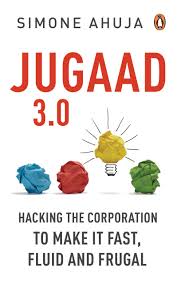
Dr. Simone Ahuja is the founder of Blood Orange, an innovation and strategy consulting group with special expertise in innovation, jugaad (or frugal) innovation, and intrapraneurship (innovation execution).
Jugaad 3.0 offers an outstanding guide for intrapreneurs to successfully drive innovation from within an established organisation. Using a fast and frugal approach common to an entrepreneurial startup, Jugaad 3.0 organisations can build their ability to innovate and create an approach for growth that harnesses the creativity and knowledge of employees at every level.
Draw inspiration from the eight J3.0 Principles!
- KEEP IT FRUGAL
- Remain asset-based
- Keep it simple
- Encourage frugal experiments
- Focus on teams
- Rethink incentives
- MAKE IT PERMISSIONLESS
- Support, don’t control
- Say ‘yes’ more often
- Add light structure
- LET CUSTOMERS LEAD
- Create leading-edge customer focus
- Hack better access to customers
- Turn customers into innovation partners
- Make intrapreneurship a sales priority
- KEEP IT FLUID
- Create a team of teams
- Make management fluid
- Support agility to structure
- MAXIMIZE ROI
- When it doubts, test it out
- Make learning a priority
- Measure Return of Intelligence
- Make failure feasible
- CREATE THE COMMONS
- Plan for full inclusion
- Make it safe to innovate
- Use technology in appropriate measure
- Train future intrapreneurs
- Create porous networks
- ENGAGE PASSION AND PURPOSE
- Make purpose programmatic
- Leverage passion that bubbles up
- Push passion viral
- ADD DISCIPLINE TO DISRUPTION
- Develop multiple streams of innovation
- Create a culture that enables hybridity
- Manage disruption with discipline
One Year In India
This article chronicles my experience as a V.I.E candidate in India from September 2018 to August 2019.
Part I – A Unique Professional Contract
The V.I.E contract is a win-win contract for all the main stakeholders:
- Business France, the international development agency of the French economy, is promoting the success of the V.I.E program. The more V.I.E candidates, the stronger Business France; the more talented the V.I.E candidates, the more credible Business France; the more countries the V.I.E choose, the higher the international presence of Business France.
- The France-based company is minimizing the risks and maximising the success of its international development. Indeed, the France-based parent company benefits from some financial incentives (such as tax reduction, international growth loan, export tax credit, special insurance, regional aids), human resource support (such as candidates short listing), local administrative support (such as visa issuance), a market entry advisory (such as a country guide published by Business France), as well as business services (such as networking events and business meetings with local corporates).
- The V.I.E candidate holds a special contract perfectly designed for a successful international experience at the beginning of a career. The V.I.E contract offers flexibility and safety. This package of advantages generally sets the right conditions to young graduates to perform in good time in their host country.
Part II – Multi-faceted Assignments
In theory, Business France states that the missions of the V.I.E candidates could be as diverse as market research, commercial prospecting, site monitoring, participation in the start-up of a local structure, animation of a distribution network, technical support, etc.
In reality, I can guarantee it is the case! As a consultant, my role is threefold. First, I am involved in consulting projects for Indian and French companies. My three domains of expertise are the following: Salesforce (CRM, Lead Management, Open Innovation, Smart Selling, etc.), Data Science (Customer Segmentation, Dynamic Pricing, Forecasting Demand, etc.) and Benchmarking (Market Analysis, Competition Analysis, etc.). Second, I support the management in handling internal activities such as human resources, administrative, accounting, public relations and marketing requirements. Last, I support the sales team to acquire new leads and win new data-driven projects.
As language barriers are often a source of misunderstanding, I am responsible for an effective communication between France and India. During our weekly call with the managers, we review all past activities and set up the goals of the next week. I am also in charge of the follow-up of the projects I am involved in in terms of quality delivery and deadline.
Part III – Unforgettable Experiences
Empowering Professional Experiences
I am particularly delighted to see our Salesforce team achievements. We started with one project and one vision. Today, we have two live projects, several ongoing prototypes and quite a few of innovative new projects in the pipeline. We have a team of four Salesforce hybrid consultants who support each other. Our strengths lie in the collaborative mindset and mix of competences such as client-facing, training and development skills.
Valuable Personal Experiences
A V.I.E experience is usually both professionally intense and full of local discoveries: people, cultures, languages, traditions, gastronomy, religions, functions, landscapes, etc.
Conclusion
The V.I.E program is an outstanding opportunity to start a career abroad for a young graduate. During this year in India, I have acquired technical and managerial skills, built an extensive network in India as well as in France and unlocked my open-mindedness.
Alexandre PERSON
Article published on June 4, 2019
Appendix 1: Government initiatives to boost and ease doing business in India
- Make in India
- Digital India
- Smart Cities
- India Innovation Growth Programme 2.0
- Invest in India
- Innovate India
- Skill India
- Startup India
- Transforming India
- GIFT (Gujarat International Finance Tec-City)
Appendix 2: What is a “VIE Program”?
The International Corporate Volunteering, in French “Volontariat International en Entreprise” (V.I.E), is a public status managed by Business France (a national agency at the service of the internationalization of the French economy).
The V.I.E is a solution for the international mobility of young professionals, which is the subject of tax benefits and financial assistance beneficial to companies.
The V.I.E. allows a company governed by French law to entrust a young man or woman, aged 18 to 28, with a professional assignment abroad lasting from 6 to 24 months, renewable once within this limit.
The company may entrust the V.I.E. deployed abroad with the following missions (non-exhaustive list):
- Study and prospecting of new international markets
- Reinforcement, technical or commercial, of local teams in place
- Support of a contract, a construction site
- Search for partners, agents or distributors
- Creation or implementation of local structures
The V.I.E. is generally assigned to only one country. However, the “Regional V.I.E.” allows companies to carry out prospecting or monitoring activities in several countries in a geographical area (maximum 8: the country of assignment plus 7 other countries).
Chandon India Winery

On Friday 10th of May 2019, we had the exclusive opportunity to visit Chandon India Winery. Located in Dindori, Nashik, Chandon India is the first offering from Moët Hennessy to be made in India, combining the centuries-old sparkling winemaking practice with the finest local grapes.
Part I – Journey to the Winery
We arrived in Mumbai the day before so that we could grasp a bit of the furious energy of the vibrant city. On Friday morning, we took a frugal breakfast at our hotel near by the airport. By 8.30am, we were ready to take the 3.5-hour long journey to Nashik, an ancient holy city in the northern region of the Indian state of Maharashtra.
We hired a cab and ventured deep into the loud and crowded Mumbai metropolis. We needed almost an hour to exit the city. Then, the road became monotonous, the desert-like landscape looked similar for the rest of the drive.
We arrived at our hotel in Nashik by exactly 12pm. After unpacking and freshening up, we explored the hotel. We could feel immediately that we reached a new world, compelety different from the one we left behind: it was indeed calm, quiet and slow. And we quickly realized we landed in the wine region of India. Colorful paintings explaining wine making processes, a beauteous wine bar and a luxury wine shop showcasing the two wine giants of the region (Sula Vineyards and Chandon India). Indeed, Nashik has been recognized as the Wine Capital of India as half of India’s vineyards and wineries are located in Nashik.
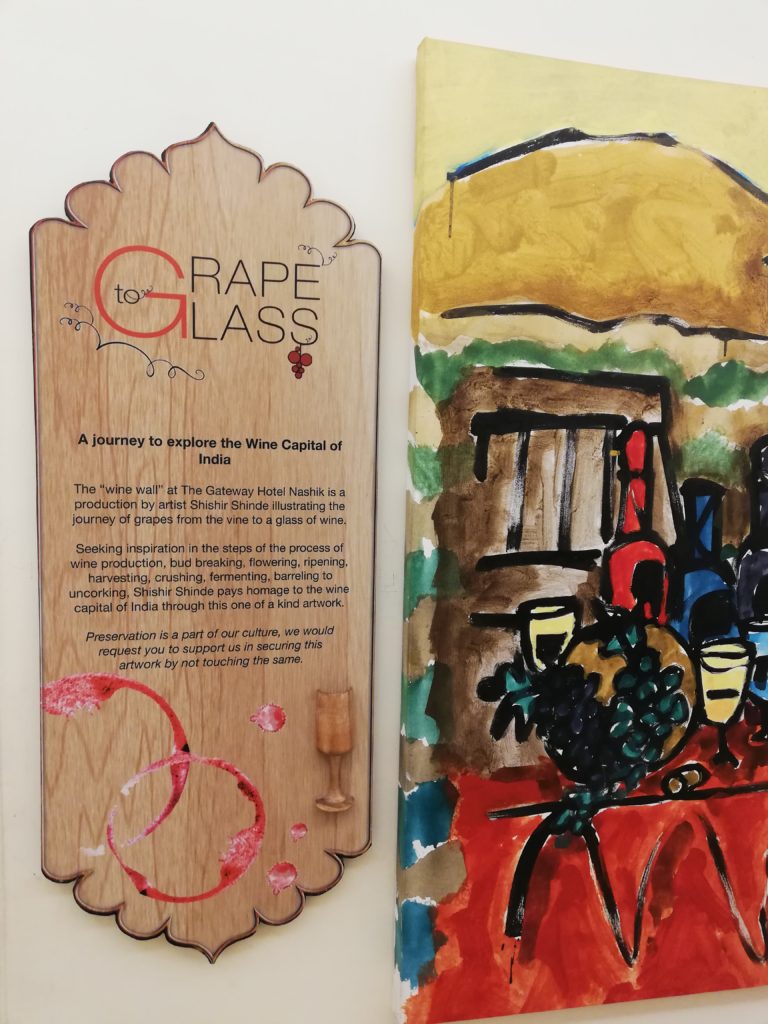
Part II – Arrival at Chandon India Winery
After an epic 45min-drive in the bush, taking narrow dirt roads, we were finally able to sight the gate of the vineyard. The blossoming and lush garden was a breathtaking scenery. A quick glance at the surroundings and one understands that the winery has been built at the foot of the hills.


We came in the hall and Chandon India team welcomed us warmly. We were offered the special MyChandon welcome drink. This drink aims first to refresh yourself after a long journey. It also aims to break with the traditional codes. Indeed, you drink sparkling wine using a straw! The experience was surprising, though fun and tasty. It is worth mentioning that the refined interior decoration as well as the sublime exterior view to the valley were mind blowing.
Then, Mr. Amrut Vare, experienced winemaker at Chandon India, took us to another room to discover the history of Chandon. He explained that everything started in 1957 with a man, Count Robert Jean de Vogüé, and a vision, “We must export know-how, not bottles“.

Amrut reminded us key dates such as:
- 1959: Bodega Chandon Argentina is established in Valle de Uco
- 1973: Domaine Chandon California is founded in the heart of Napa Valley and Domaine Chandon Brazil is set up at Rio Grande do Sul
- 1986: Domaine Chandon Australia is created in the heart of the Yarra Valley
- 2013: Chandon India is created in Nashik, available in two variants Chandon Brut & Chandon Brut Rosé
- 2014: Chandon China is founded at the heart of the Ningxia Hui Autonomous Region
- 2017: Chandon India launches its newest variant Chandon Délice
Subsequently, he outlined the reasons why Chandon has chosen India to build the fifth Chandon winery. Among them, he mentioned the following motivations:
- With a population of over 1.3 billion inhabitants, 67% of whom are under the age of 35, India is not only the largest but the youngest democracy with an ever increasing discretionary spend
- India is also currently the 5th largest economy in the world and estimated to be the world’s second largest economy by 2025
- India is predominantly a brown spirits market but the highest growth is coming from the super premium segment which comprises of all different spirits
- The current young consumer who is also part of the Chandon target consumer compresses of a generation who is looking for the best experiences and best brands
- Going out and eating out is becoming very popular: new outlets (including wine outlets) opening up with experiential cuisines and decors and pre-gaming is still big amongst the younger Xennials and Millennials
India is definitely a potential untapped consumer market for luxury brands such as Chandon. However, is it wine friendly?
- India has been known for its significant consumption of spirits. The IWSR 2018 report showed about 314Mn cases of alcohol excluding beer (27Mn hectoliters) was sold the prior year with majority being brown spirits. Wine, though very small 1% at 3Mn cases, has tremendous potential, especially sparkling wine which is growing in double digits.
- Wines in India have seen a sudden upswing with more players entering the market.
- This can all be attributed toward a more engaged and educated consumer who is extremely socially connected.
Finally, Amrut stressed two of the main wine production regions in India:
- The Nashik & Sangli Valleys in Maharashtra are good terroirs for grape varieties such as Chenin Blanc and Shiraz
- The Bangalore Valley in Karnataka is a good terroir for grape varieties such as Cabernet Sauvignon and Merlot

Part III – Wine Tasting
Following the elaborate history session, we moved to the tasting room. The excitement was amazing. Finally, we were about to tatste the sparkling nectar of Chandon India!
The wine tasting session was moderated by Mr. Kaushal Khairnar, Winemaker at Moet Hennessy India. He acquired significant knowledge about wine in France where he graduated in 2014 from Montpellier SupAgro University in European Master of Viticulture and Enology. He learnt the wine making process in different regions of the world such as Portugal, New Zealand, the United States, Brazil and France as an assistant wine maker. He became wine maker of Chandon India Winery in April 2018.

The agenda was the following:
- CHANDON Brut
- CHANDON Brut Rosé
- CHANDON Délice
1. CHANDON Brut

Produce of India
(750mL, Alc 12.5% v/v)
Kaushal first introduced the iconic Chandon Brut sparkling wine. This 2015 vintage is a blend of Chenin Blanc (70%), Chardonnay (15%) and Pinot Noir (15%). Moving forward, he asked: “Do you know why we call this wine ‘Brut’?” After unconvincing answers, Kaushal explained that it is linked to the sweetness scale. According to the quantity of residual sugar per liter in the bottle of wine, we have the following classification:
- Brut Nature: 0 < x < 3 g/L
- Extra Brut: 0 < x < 6 g/L
- Brut: 0 < x < 12 g/L
- Extra Dry: 12 g/L < x < 17 g/L
- Dry: 17 g/L < x < 32 g/L
- Demi Sec: 32 g/L < x < 50 g/L
- Doux: x > 50 g/L

Next, Kaushal helped us to describe the wine in three consecutive steps:
- Color
- Aromas
- Taste
At the first glance, it was easy to say that the Chandon Brut is lemon green in color. Looking more attentively at the glass, we were to able to observe the bubbles. The small-sized bubbles rised to the top with consistency. According to him, this a sign of good quality sparkling wine. In the contrary, a low quality sparkling wine is characterised by big bubbles that don’t remain for long and move randomly to the top. Several reasons could explain this behavior. Kaushal touched on the storage temperature: if the temperature is too high, the CO2-bubbles burst; if the temperature is too low, the flavours disappear. He suggested that a constant storage temperature at 14°C for 36 months is the right condition to get perfect bubbles in sparkling wines. He added that some wine makers make the choice to add artificial CO2 that can lead to low quality bubbles in sparkling wines.
The aromas of the Chandon Brut could be described as follows:
Chandon Brut is straw yellow with flashes of green and a fine persistent effervescence. A bright, fresh fruit bouquet of citrus blossom with green apple and hints of tropical fruits and vanilla.
Last but not the least, we tasted the wine! Theoretically, we should have tasted the same aromas we had smelt earlier… We all tried our best to figure out the right fruits the Chandon Brut was offering us. Some succeeded, some did not. Nevertheless, we all enjoyed the first glass of Chandon!
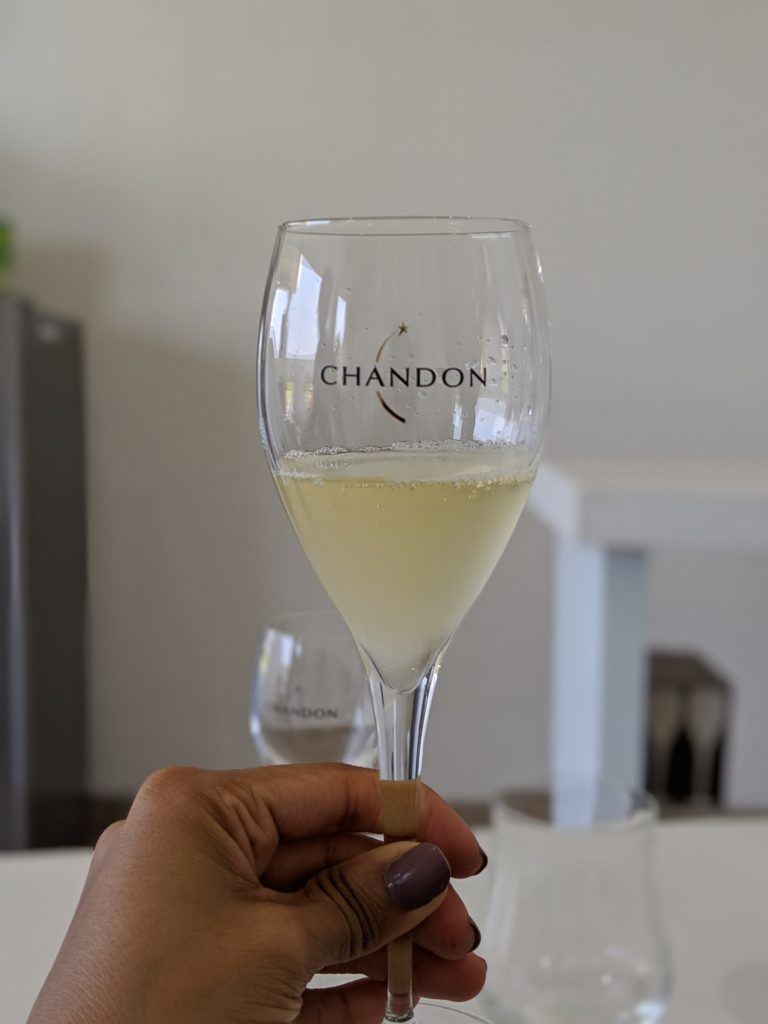
#1 CHANDON Brut
2. CHANDON Brut Rosé

Produce of India
(750mL, Alc 12.5% v/v)
Next, we moved on and Kaushal opened the Chandon Brut Rosé. “This vibrant rose gold with hints of pink peach skin and a fine persistent effervescence” is 100% made with Shiraz. Apparently, the Nashik Valley is particularly suitable for Shiraz as the nights remain cool and the fluctuations in temperature are quite low. The pink color of this wine was a good opportunity to remind us where the color in wine comes from. The common answer is that red wines are made with red grapes (Pinot Noir, Cabernet Sauvignon, etc.) and white wines are made with white grapes (Chardonnay, Pinot Grigio, etc). Thouh, surprisingly, it is possible to make white wine with red grapes! In fact, red wines get their color from the juice fermenting with the skins and seeds of red grapes (the skin of red grapes contain a pigment called anthocyanin); while white wines are pressed off of the skins and the seeds before being fermented (Source: Wine Folly). Thus, rosé wine happens when the skins of red grapes touch wine for only a few hours, whereas some red wines ferment for weeks at a time on red grape skins (Source: Wine Folly).
For this wine, Kaushal underlined “the intense aromas of ripe cherries with mouth-filling flavours of red fruits and soft grapefruit undertones lead to a rich, creamy, persistent finish”. Some of us also noticed spices and dry chilli aromas.
As we were tasting the wine, we observed the Rosé was a bit sweeter than the Brut.

#2 CHANDON Brut Rosé
3. CHANDON Délice

Produce of India
(750mL, Alc 12.5% v/v)
Last, Kaushal opened the bottle of Chandon Délice. The blending is 60% of Chenin Blanc and 40% of Chardonnay. This sparkling wine has been launched in 2017, three years after the release of Chandon Brut and Chandon Brut Rosé. As a Demi Sec (sweetness level at 45 g/L), this wine is much sweeter than the two previous Brut wines (sweetness level below 12 g/L).
Fresh and easy to drink, Chandon Délice can be drank in three ways according to your mood:
- With a flute
- With 2 ice cubes on the rocks
- With a slice of orange (like on the photo below)

#3 CHANDON Délice
This 1-hour wine tasting was a mesmerizing experience for both connoisseurs and beginners alike. The newcomers can discover the basics of making wine and wine tasting and the amateurs can satisfy their curiosity about the New World wines from India.
We left the wine tasting room and headed to the terrace to have a tasteful Indo-French lunch buffet.
Part IV – Winery Visit
From harvest to consumption, you need at least two years of work. In Nashik region, harvest occurs once a year in the months of January and/or February.
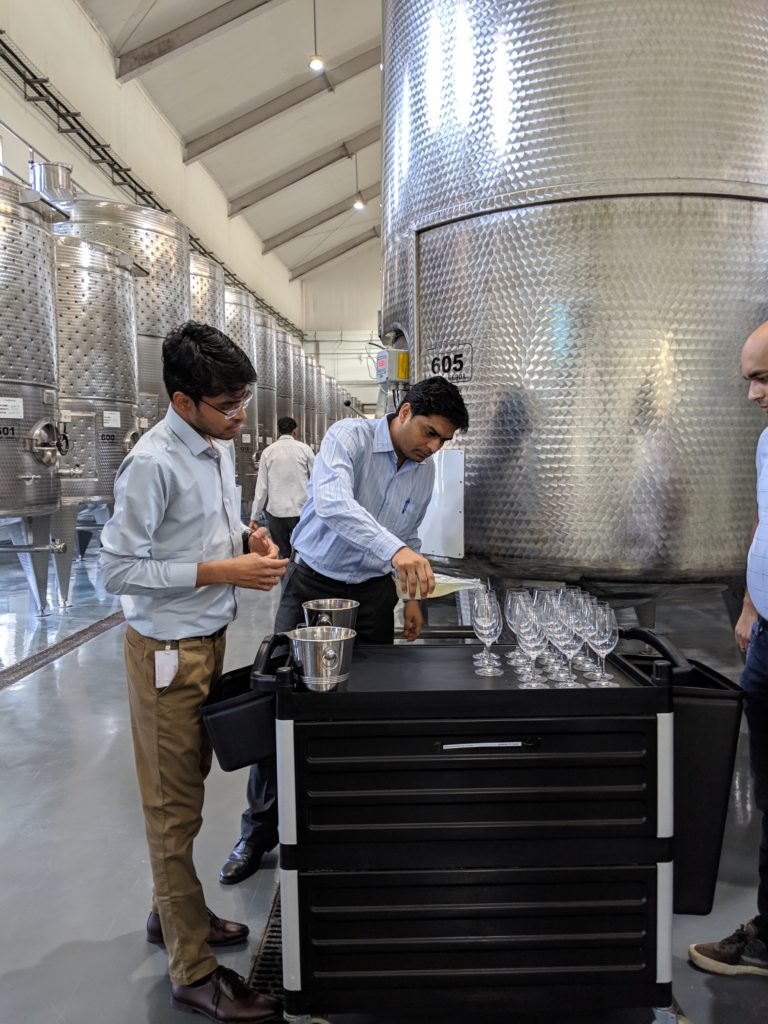

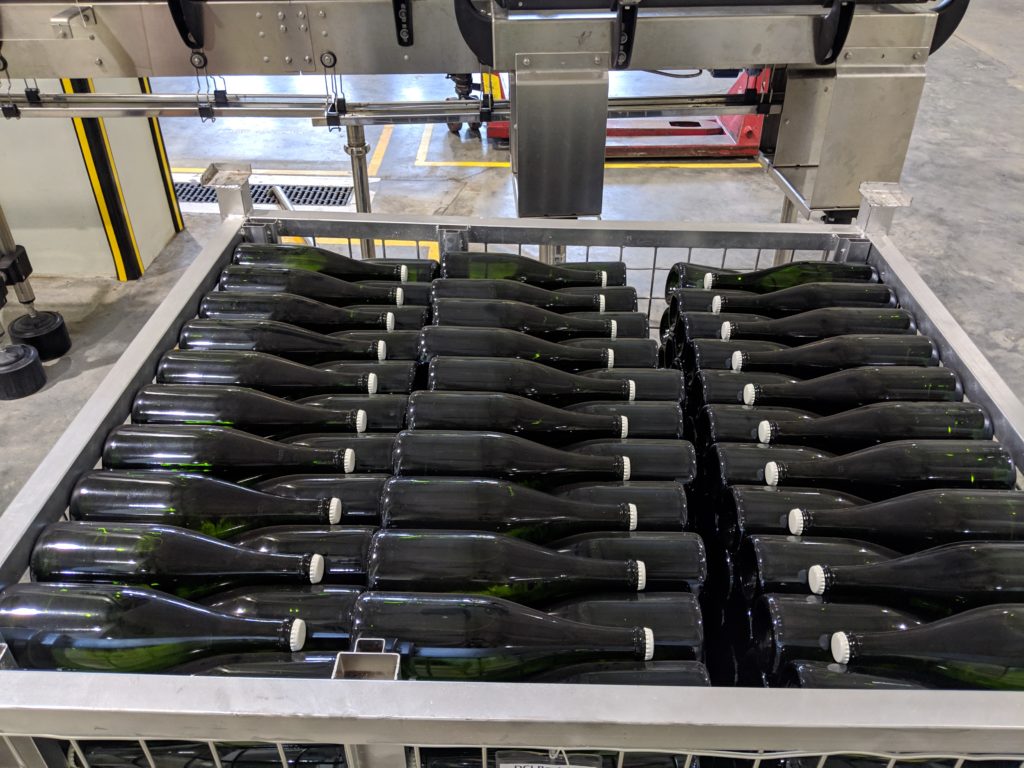
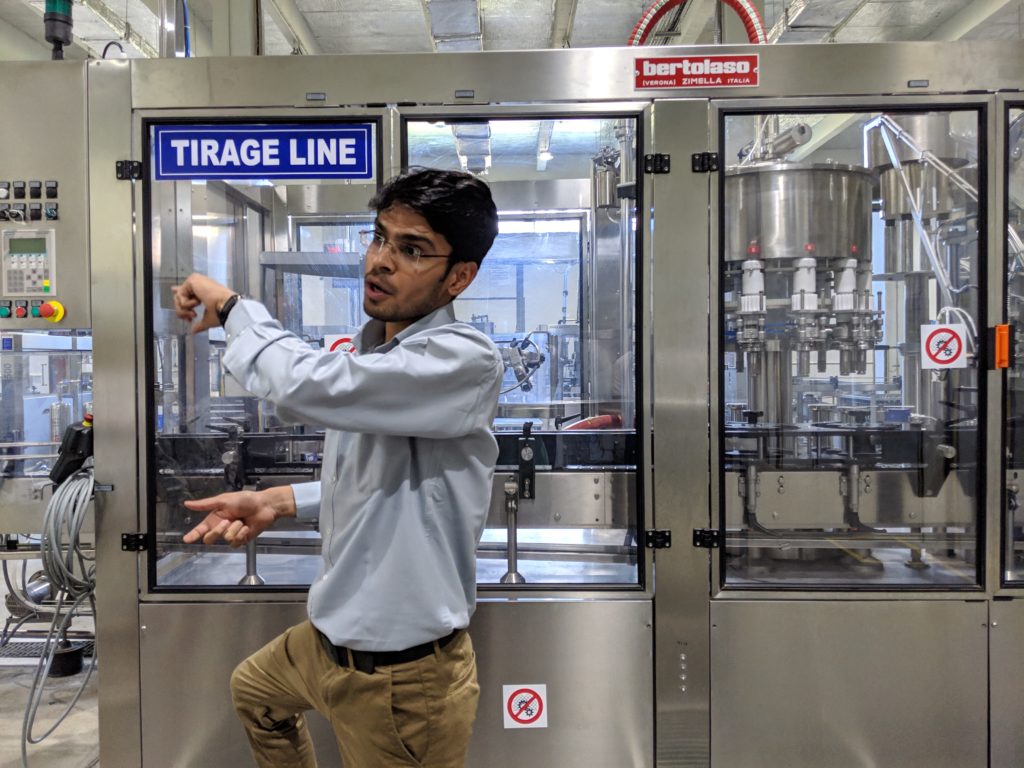

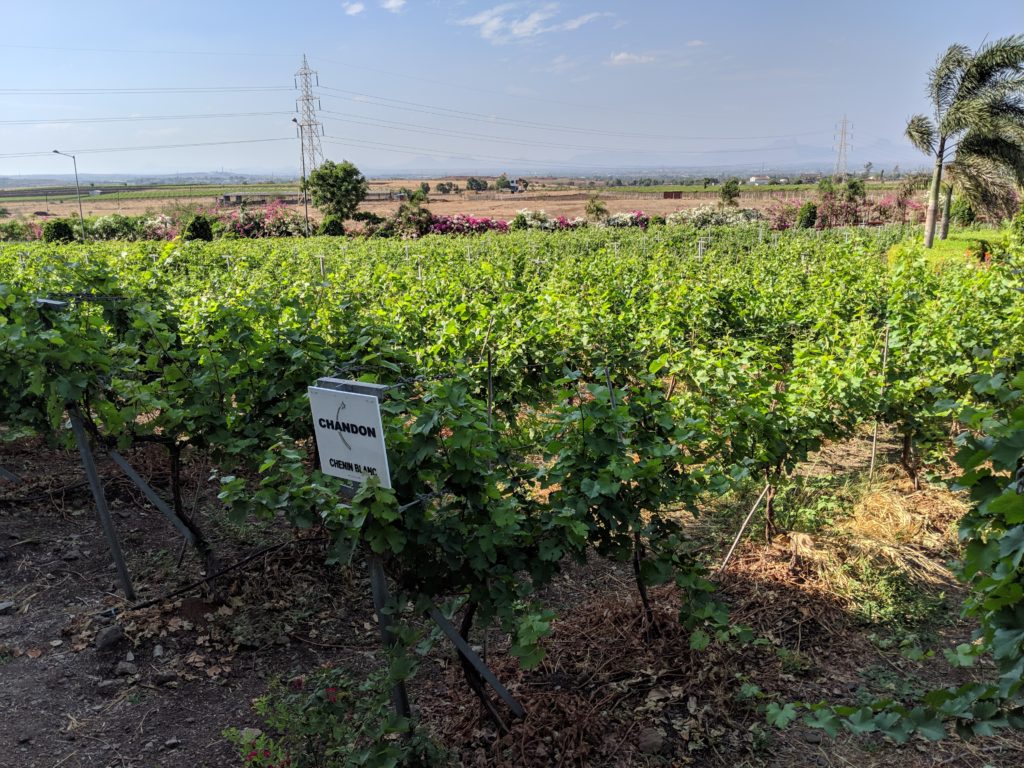
Part V – Last Moments at Chandon India Winery
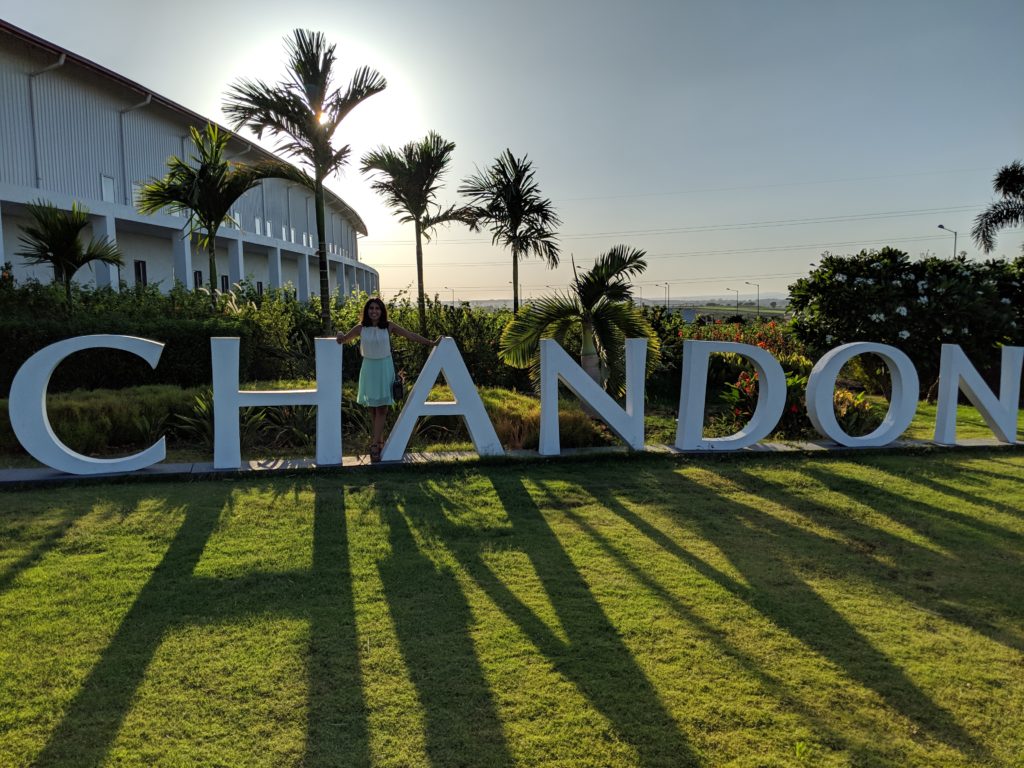
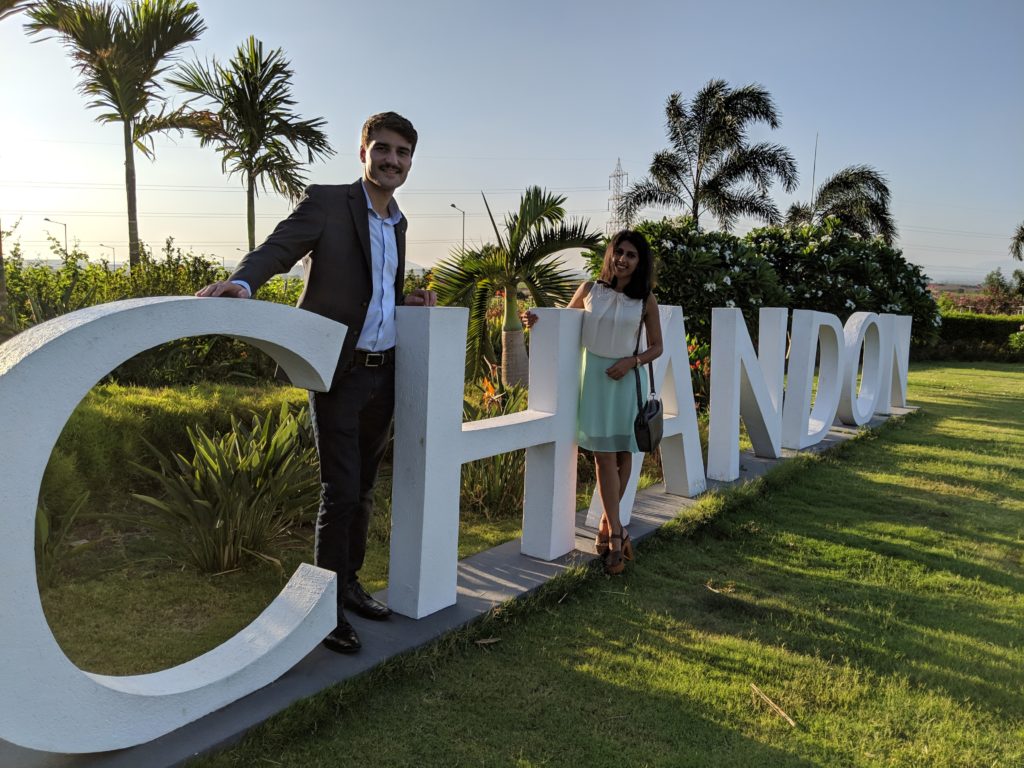
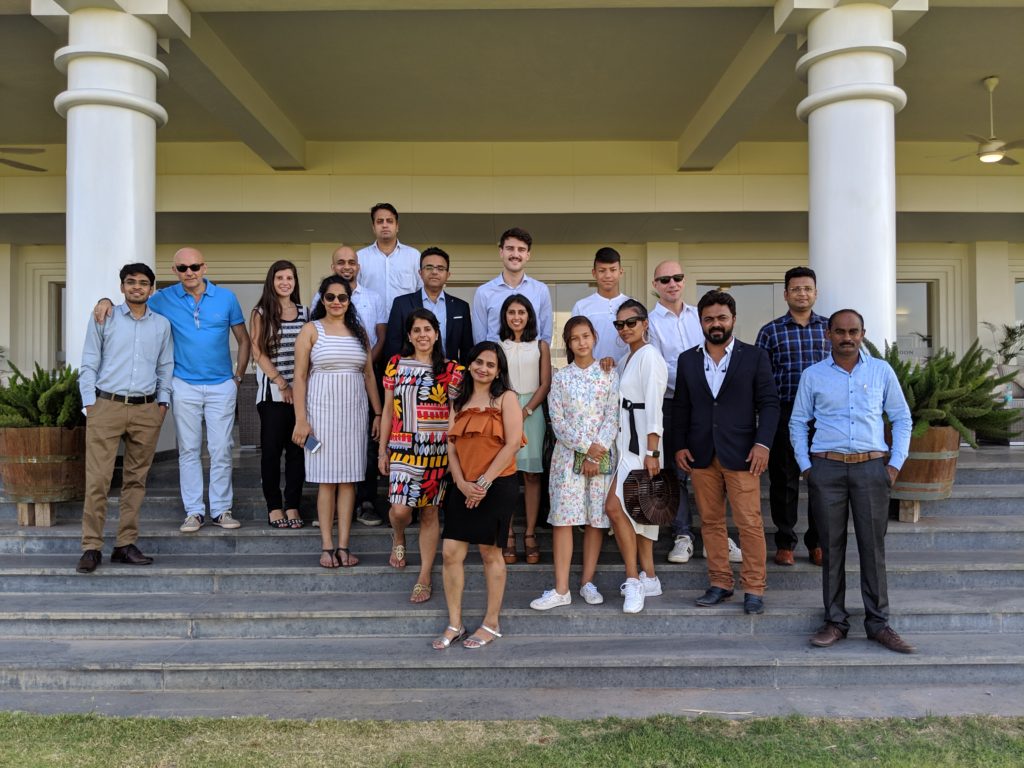

Part VI – Cheat Sheet for Wine Lovers (and Wine Snobs!)
- Chandon India
- 2013 Chandon India was founded
- 1st sparkling wine produced in India according to international standards
- 8.5 hectares surface area of Chandon India domain
- India Economics
- The Indian economy is growing fast: the projected real GDP is expected to reach 7.3% in 2019 (Source: IMF)
- India’s 2019 population is estimated at 1.37 billion (Source: IMF)
- India urban population has risen from 17.9% in 1960 to 33.6% in 2017 (Source: World Bank)
- India has more than 50% of its population below the age of 25 and more than 65% below the age of 35 (Source: Wikipedia)
- Incomes will almost triple over the next two decades and the country will become the world’s fifth–largest consumer market by 2025 (McKinsey Global Institute, 2007)
- Wine, Beers and Spirits in India
- According to Statista, revenue in the spirits segment amounts to US$34,476m in 2019 in India and the market is expected to grow annually by 6.7% (CAGR 2019-2023). India stands in the top 3 behind China (with a market volume of US$134,455m in 2019) and the USA (with a market volume of US$83,949m in 2019).
- Statista estimates that revenue in the beer segment amounts to US$14,188m in 2019 and the market is expected to grow annually by 7.7% (CAGR 2019-2023). In global comparison, most revenue is generated in United States (US$115,678m in 2019).
- Revenue in the wine segment amounts to US$0.1m in 2019 according to Statista. The market is expected to grow annually by 21.4% (CAGR 2019-2023). In global comparison, most revenue is generated in United States (US$49,570m in 2019).
For visiting the Chandon India Winery, please get in touch with Amrut Vare
- Email: amrut.vare@moethennessy.com
- Phone: +91 83089 79899
Drink responsibly.
Sources:
Article published on May 27, 2019
Wine in India
- Sula Seco, India (Rs 550)
- Casablanca Vino Spumante, India (Rs 1000)
- Zampa Soirée Brut, India (Rs 1200)
- Fratelli Gran Cuvee Brut, India (Rs 1100)
- York Sparkling Cuvee Brut, India (Rs 1100)
- Chandon Brut / Brut Rosé, India (Rs 1200 Brut, Rs 1400 Brut Rosé)
- Sula Brut, India (Rs 1000)
Source: Mumbai Foodie
Wine in France
I am pleased to introduce you to my family-run winery, Jalousie Beaulieu!

You can also check out our online shop here!
Has India’s Demonetization policy worked?
According to my reading, I stand for Indian Prime Minister’s currency policy to demonetize the 500- and 1000- rupee notes. After giving a definition of demonetization, I state the goals of the policy. Then, I analyse the pros and cons of the demonetization in India at the time of the announcement in November 2016. Based on the recent news, I look at the short term impacts of the policy. In particular, I explain in what extent the policy has not reached the main initial stated goals. Although the failure of the policy regarding its goals is acknowledged, demonetization has tangible and concrete positive effects in India, which will benefit to the whole country in the long run.
Investopedia defines demonetization as “the act of stripping a currency unit of its status as legal tender”. The Times of India explains that demonetisation is a situation where the Central Bank of the country withdraws the old currency notes of certain denomination as an official mode of payment”.
Content and Goals of the policy
In 2016, the Indian government decided to demonetize the 500- and 1000- rupee notes, the two biggest denominations in its currency system; these notes accounted for 86% of the country’s circulating cash. With little warning, India’s Prime Minister Narendra Modi announced on November 8 that those notes were worthless, effective immediately and gave his country’s 1.3 billion people a 50-day window to deposit or exchange them for newly introduced 2000 rupee and 500 rupee bills. The government’s main goal was to combat India’s corruption and thriving underground economy on several fronts:
- Eliminate black money gotten from money laundering and terrorist-financing activities,
- Eradicate counterfeit currency,
- Fight tax evasion (only 1% of the population pays taxes).
SWOT Analysis
To assess India’s demonetization policy, I use the SWOT analysis (Strengths, Weaknesses, Opportunities, Threats). I first investigate the internal strengths and weaknesses of the policy and then explore the long term opportunities and the threats of the move.
The key strength of Modi’s move was the surprise effect . As only few people are aware of the announcement, it prevents black money holders to plan and build complex financial operations to launder their money. Modi’s policy has five main weaknesses though. First, the move causes extra cost as the Reserve Bank of India (RBI) has to spend 79.65 billion rupees on quickly printing updated replacements for the 500 rupee and 1,000 rupee notes. Second, the move may generate substantial notes shortage in the days following the announcement as everybody can physically not deposit or exchange their notes as the same time. Moreover, ATMs are not calibrated for the new sized bills and half the people in the country would need to open a bank account for the first time if they want to deposit their old notes. Third, the timeline is tight that can lead to some panic. Considering India’s population, it may lead to long lines at banks and ATMs and large queues from forming outside bank branches and automated teller machines. Fourth, the policy might be unfair as it might hurt the weakest sections of India’s society, specifically daily-wage labourers, small traders and businesspersons, farmers, women and senior citizens. Last but not least, the policy might be drastically ineffective as black money holders keep only 6% or less of their wealth as cash, suggesting that targeting this cash would not be a successful strategy.
Regarding the long term effects of the policy, demonetization has attractive opportunities and big threats for India. On the one hand, demonetization might be the perfect opportunity for small and medium businesses to develop and offer innovative digital payment solutions . On the other hand, Modi has to pay attention to some issues as he can be accused of damaging the economy and tarnishing the country’s credibility at home and abroad. On the economical side, the policy could provoke a slowdown in economic growth and a decrease in industrial production. On the political side, Prime Minister and his party BJP can lose popularity, credibility and trust both nationally and internationally if the policy is a failure.
One year after the demonetization, is the policy a success?
Data released by the RBI indicates that demonetization has failed to flush out black money . It said in its annual report on August 30 that 99 percent, or around 15.28 trillion rupees ($238.7 billion), of the demonetized 500- and 1,000-rupee notes were deposited or exchanged for new currency. That figure suggests that most people (including corrupt officials, businessmen and criminals said to have hoarded their illicit wealth in cash) have managed to preserve their fortunes. One of the reason of this failure was that India’s black market rarely stores money in cash, as its players prefer other ways of storing wealth, such as jewelry or property (see weaknesses above). Second, demonetization has failed to eradicate counterfeit currency . Indeed, counterfeits of the new 2,000 rupee notes began emerging almost as soon as the legitimate ones were minted.
On top of that, the policy might be involved in the slowdown of the economy. A Parliamentary panel report in April 2017 stated that rural households and honest taxpayers were the worst hit by demonetisation. It said that it was not just the poor that suffered, but the manufacturing sector was impacted too. According to the panel, demonetisation created significant disruption throughout economy, because it was carried out without prior study or research. By reducing money supply, demonetization has also acted as a temporary drag on India’s gross domestic product: The country’s second quarter GDP growth fell to 5.7 percent, which was below a consensus estimate of 6.6 percent for that quarter.
Secondary benefits
Although India’s demonetization policy failed to purge black money from the market, the move has had “secondary benefits” such as fiscal improvement, economic boost, and political benefit.
First, demonetization has widened the tax base and eased tax collection . Modi’s ministers and government spokespersons say there has been an 18 percent rise in income tax returns over the last year after demonetisation. Moreover, the policy was actually a stark success in its ability to get people to open bank accounts for the first time and to get acquainted with electronic payment systems. The way this was carried out was straightforward: people weren’t really given another choice. Reinforcing Modi’s Digital India strategy, which aims to expand India’s online infrastructure, the country now sits on a treasure trove of data. The government has been gradually making enrolment to its national electronic database ‘Aadhaar’ mandatory for tax returns, opening of bank accounts and any purchases above 50,000 rupees. It is estimated that over 99 percent of Indians aged 18 and above are now enrolled in the scheme. Forecasters even expect the country’s tax base to grow larger and help drive the GDP in the fourth quarter to around 8 percent.
Second, demonetization has facilitated the rise in digital financial services. Traditional payment methods, such as bank transfers and debit cards, have been increasing. Innovative financial instruments have also been booming such as mobile banking and and e-wallets. Paytm, India’s largest digital payments company and backed by Alibaba, Ant Financial, and Softbank, is looking to expand its footprint to include lending services and credit cards for customers. Paytm has already secured a banking license and launched Digital Gold, which allows users to buy, sell. and store the precious metal pegged to real-time market rates. “Fintech companies are joining in and banks are encouraging mobile banking through specially created apps” said Professor Charan Singh, who teaches monetary economics at the Indian Institute of Management Bangalore. “Demonetization should not be viewed in a narrow sense as simply searching for unaccounted money” he added, “it will meet the aspirations of young population, improve India’s rank in Ease of Doing Business and encourage growth.”
Third, Prime Minister Narendra Modi largely benefited from his move on the political level . His party, BJP, saw a resounding electoral win in March, following implementation. “It’s important to remember that the demonetization move was intended more as a political move than as an economic one” noted New York-based South Asia-focused Eurasia Group analyst Sasha Riser-Kositsky. He explained that “the drama of demonetization allowed Prime Minister Narendra Modi to demonstrate in a very visible way his commitment to fighting corruption and black money”. Capital Economics’ Shah added that the scheme appeared to be a political success for the Modi government: “After all, the measures enabled PM Modi to demonstrate in a very visible way his commitment to fighting corruption and black money (even though they proved to be a failure). This helped the ruling BJP to secure major victories in state elections earlier this year”.
Conclusion
Although 2016 India’s demonetization has failed to reach its main stated goal, ie eliminate black money, and hurt the economy in the short run, Prime Minister Narendra Modi’s policy has created the favourable conditions for the further development of a more secure, reliable, buoyant, flourishing and digital economy in India. Above all, Modi has shown his ability to unify the country and gather all citizens, whatever their social, religious or financial status, to a common vision. The remaining questions are: Back in November 2016, did Narendra Modi have other alternatives? Would he have been able to create ingenious and less costly measures or policies to achieve the stated goals of demonetisation and still bring the same ‘secondary benefits’ that are currently happening in India?
Alexandre PERSON
Released on December 8, 2017
Sources:
- https://timesofindia.indiatimes.com/topic/Demonetisation
- http://www.hindustantimes.com/opinion/digitisation-of-india-s-economy-is-the-success-story-of-demonetisation/story-ghQdJ9a9H8fs0i57bHvJ3H.html
- http://www.thehindu.com/todays-paper/tp-business/currency-in-public-hands-surges/article20376142.ece
- http://indianexpress.com/article/india/demonetisation-pm-modi-carried-forward-ambedkars-theory-in-letter-and-spirit-says-devendra-fadnavis-4933442/
- https://www.investopedia.com/terms/d/demonetization.asp
- https://www.investopedia.com/news/india-discontinues-500-and-1000-rupee-currency-notes-hdb-ibn/
- http://www.aljazeera.com/indepth/features/2017/11/demonetisation-modi-cash-gamble-divided-india-171108065749571.html
- http://www.aljazeera.com/indepth/features/2017/11/day-protests-mark-demonetisation-anniversary-171107074631199.html
- http://www.aljazeera.com/programmes/insidestory/2017/11/india-currency-policy-worked-171108185812057.html
- https://economictimes.indiatimes.com/news/economy/policy/demonetisation-economy-shaken-gdp-hurt-trust-in-govt-undermined/articleshow/61182455.cms
- https://www.ft.com/content/7dbe0e14-8d8a-11e7-a352-e46f43c5825d
- https://en.wikipedia.org/wiki/2016_Indian_banknote_demonetisation
- https://www.cnbc.com/2017/09/01/indias-demonetized-currency-back-in-the-system-but-canwe-still-call-it-a-success.html
- https://www.cnbc.com/2017/09/07/demonetization-reserve-bank-of-india-suggests-that-demonetisation-allowed-black-money-to-enter-banking-system.html
- https://www.cnbc.com/2017/06/23/india-digital-payments-giant-paytm-offering-credit-card-and-lending.html
- https://thediplomat.com/2017/09/is-indias-demonetization-a-failure/
- https://www.forbes.com/sites/wadeshepard/2017/07/29/how-india-is-surviving-post-demonetization/#407c84111164
